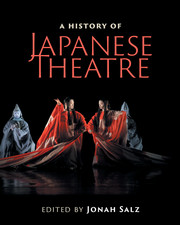Book contents
- Frontmatter
- Contents
- List of figures
- List of tables
- Contributors
- Contributors’ biographies
- Foreword
- Acknowledgments
- Note on Japanese terms
- List of abbreviations
- Timeline
- Editor's introduction
- I Traditional theatres
- Preface to Part I Japanese civilization arises
- II Modern theatres
- Preface to Part II
- 6 Birth of modern theatre: shimpa and shingeki
- Interlude Modern comedies and early musicals
- Interlude Takarazuka: all-girls’ revue and musicals
- 7 Rise of shingeki: Western-style theatre
- Interlude Manzai and Yoshimoto vaudeville comedy
- 8 Wartime colonial and traditional theatre
- Interlude Kami-shibai: picture-card storytelling
- 9 Maturing shingeki theatre
- Interlude Postwar musicals and commercial theatre
- 10 Sixties Theatre
- Interlude Butoh: dance of darkness and light
- 11 Contemporary theatre
- Interlude Tokyo: world theatre capital
- Interlude Charting Tokyo theatre today: 24 November 2012
- Interlude Modern theatre tomorrow: interview with Oriza Hirata
- III Arcs and patterns
- IV Theatre architecture
- Preface to Part IV Evolution of Japanese theatre architecture
- V Theatre criticism
- VI Intercultural influences
- Epilogue: Frozen words and mythology
- Further reading
- Index
- References
6 - Birth of modern theatre: shimpa and shingeki
from Preface to Part II
Published online by Cambridge University Press: 05 July 2016
- Frontmatter
- Contents
- List of figures
- List of tables
- Contributors
- Contributors’ biographies
- Foreword
- Acknowledgments
- Note on Japanese terms
- List of abbreviations
- Timeline
- Editor's introduction
- I Traditional theatres
- Preface to Part I Japanese civilization arises
- II Modern theatres
- Preface to Part II
- 6 Birth of modern theatre: shimpa and shingeki
- Interlude Modern comedies and early musicals
- Interlude Takarazuka: all-girls’ revue and musicals
- 7 Rise of shingeki: Western-style theatre
- Interlude Manzai and Yoshimoto vaudeville comedy
- 8 Wartime colonial and traditional theatre
- Interlude Kami-shibai: picture-card storytelling
- 9 Maturing shingeki theatre
- Interlude Postwar musicals and commercial theatre
- 10 Sixties Theatre
- Interlude Butoh: dance of darkness and light
- 11 Contemporary theatre
- Interlude Tokyo: world theatre capital
- Interlude Charting Tokyo theatre today: 24 November 2012
- Interlude Modern theatre tomorrow: interview with Oriza Hirata
- III Arcs and patterns
- IV Theatre architecture
- Preface to Part IV Evolution of Japanese theatre architecture
- V Theatre criticism
- VI Intercultural influences
- Epilogue: Frozen words and mythology
- Further reading
- Index
- References
Summary
Achieving a viable theatre alternative to the venerable traditional genres in the modern period, a theatre that could resonate easily with Japan's changing society, was no easy task. This chapter charts the various steps in this quest up to the late 1920s.
Continuity, reform, and radical change
Theatre had been directly caught up in another facet of the Meiji modernizing process. An urgent preoccupation of Japan's political leaders in the 1880s had been how to convince Westerners that Tokyo really was modern. After 1883, visiting dignitaries and diplomats were treated to receptions, banquets, and balls at the Rokumeikan, a grand Western-style building constructed specifically for that purpose. Entertaining foreign visitors in a manner to which they were accustomed was bound to include the theatre, because Japanese visitors to the West had been taken to the theatre and opera in New York, London, and Paris, initially much to their amazement. To take Western visitors to kabuki – bawdy, boisterous, and officially despised – could not be contemplated, so kabuki would have to be reformed.
Reformers duly appeared from inside the kabuki world. Ichikawa Danjūrō IX (1838–1903) and Morita Kan'ya XII (1846–97) willingly and Kawatake Mokuami (1816–93) somewhat less so responded to government encouragement during the 1870s in their respective fields of acting, theatre management, and playwriting. Already in 1874 the influential intellectual journal Meiroku Zasshi (Journal of the Meiji 6 Society) had carried an article urging theatre reform, followed by vigorous intellectual debate in a number of publications in the early 1880s. This decade saw the buzzword kairyō (reform) prefixed to just about everything, but only the theatre acquired, in 1886, a “reform society” to which some of the most powerful politicians affixed their signatures.
From the present viewpoint, Japanese theatre in the modern period has had an abundance of genres. In Tokyo in the mid-1880s it seemed that it might only have one – kabuki, which the government-backed Engeki Kairyō-kai (Theatre Reform Society) was trying to refashion into a national theatre. Noh and bunraku, for their parts, were verging on the moribund. Kabuki changed in several ways after the theatre reform movement, but acting families, the core of the genre, stayed intact. A new theatre would have to emerge from outside the kabuki establishment.
- Type
- Chapter
- Information
- A History of Japanese Theatre , pp. 200 - 225Publisher: Cambridge University PressPrint publication year: 2016
References
- 2
- Cited by

